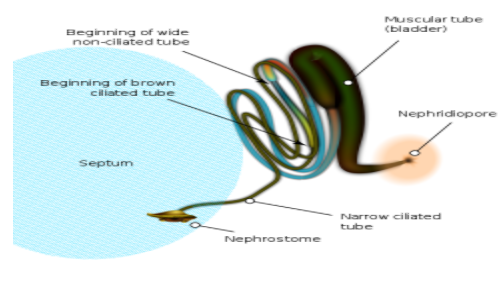Answer
378.3k+ views
Hint: For the disposal of metabolic waste of the body, excretory organs are helpful. Earthworms belong to the phylum Annelida and they are known for their metameric segmentation of the body. The metameric segmentation body is divided into segments both internally and externally and these segments are called metamers.
Complete answer:
The excretory organs in the earthworm are segmentally arranged coiled tubules. These coiled tubules are called nephridia. These regulate the volume and composition of body fluids. Integumentary nephridia are attached to the lining of segment 3 to the last that open on the body surface. Nephridiopores of the earthworm belong to integumentary nephridia.
Hence, the correct answer is option (A).
Additional information:
Nephridia are very much similar to the vertebrate kidney which expels the metabolic waste from the body. Earthworms have slightly more advanced excretory structures. Excluding the first two and last section of the body, each section contains nephridia.

In earthworms nephridia are found in clusters around parts of the body of the earthworm. Each works as waste ducts but each has a distinctive function as well. Nephridium consists of an opening called nephrostome and there is a further opening called nephridiopore.
Body fluids are pumped by the nephrostomes in a complex tubular framework and then critical substances are absorbed and waste materials are returned to the lumen and then the subsequent body fluids are carried through nephridiopores.
Note: There are three types of nephridia present in earthworms, based on the location, septal nephridia, Pharyngeal nephridia, and integumentary nephridia. Septal nephridia attached to the septa, while pharyngeal nephridia attached to the gut and integumentary nephridia attached to the inner lining of the body wall.
Complete answer:
The excretory organs in the earthworm are segmentally arranged coiled tubules. These coiled tubules are called nephridia. These regulate the volume and composition of body fluids. Integumentary nephridia are attached to the lining of segment 3 to the last that open on the body surface. Nephridiopores of the earthworm belong to integumentary nephridia.
Hence, the correct answer is option (A).
Additional information:
Nephridia are very much similar to the vertebrate kidney which expels the metabolic waste from the body. Earthworms have slightly more advanced excretory structures. Excluding the first two and last section of the body, each section contains nephridia.

In earthworms nephridia are found in clusters around parts of the body of the earthworm. Each works as waste ducts but each has a distinctive function as well. Nephridium consists of an opening called nephrostome and there is a further opening called nephridiopore.
Body fluids are pumped by the nephrostomes in a complex tubular framework and then critical substances are absorbed and waste materials are returned to the lumen and then the subsequent body fluids are carried through nephridiopores.
Note: There are three types of nephridia present in earthworms, based on the location, septal nephridia, Pharyngeal nephridia, and integumentary nephridia. Septal nephridia attached to the septa, while pharyngeal nephridia attached to the gut and integumentary nephridia attached to the inner lining of the body wall.
Recently Updated Pages
Basicity of sulphurous acid and sulphuric acid are

What is the stopping potential when the metal with class 12 physics JEE_Main

The momentum of a photon is 2 times 10 16gm cmsec Its class 12 physics JEE_Main

Using the following information to help you answer class 12 chemistry CBSE

Which of the following would not be a valid reason class 11 biology CBSE

Why should electric field lines never cross each other class 12 physics CBSE

Trending doubts
Difference between Prokaryotic cell and Eukaryotic class 11 biology CBSE

What is BLO What is the full form of BLO class 8 social science CBSE

Fill the blanks with the suitable prepositions 1 The class 9 english CBSE

Change the following sentences into negative and interrogative class 10 english CBSE

Fill the blanks with proper collective nouns 1 A of class 10 english CBSE

Difference Between Plant Cell and Animal Cell

What organs are located on the left side of your body class 11 biology CBSE

Select the word that is correctly spelled a Twelveth class 10 english CBSE

Give 10 examples for herbs , shrubs , climbers , creepers



